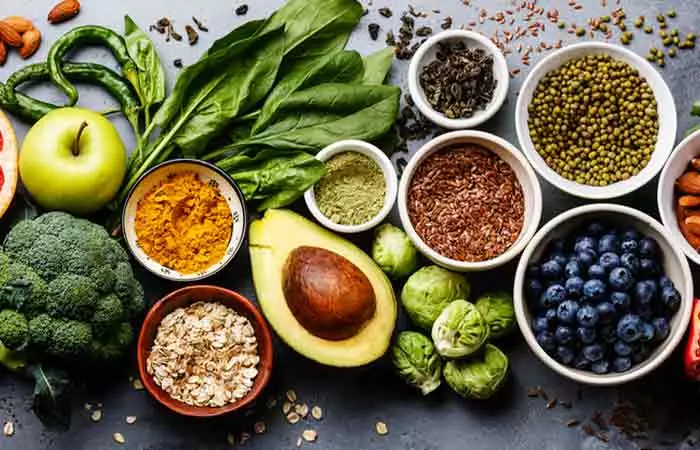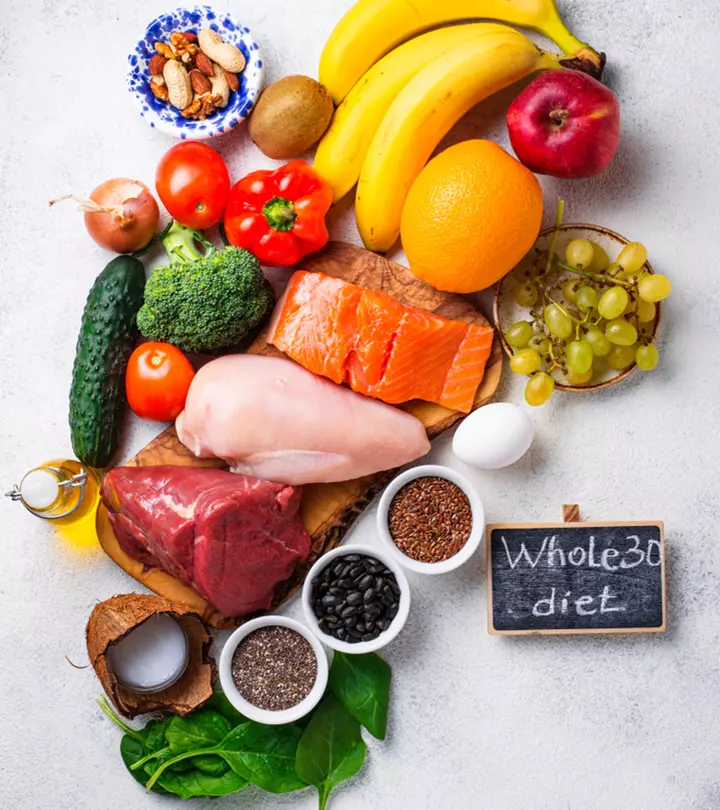The Kosher Diet: Benefits And Meal Plans
Where faith meets food and blends culinary traditions with religious devotion.

Image: Shutterstock
The kosher diet is based on a set of dietary laws that govern the type of foods the Jewish can consume and the way they should be prepared. These guidelines are outlined in the Torah, the central religious text of Judaism, and encompass various aspects of food. This includes the type of animals permitted for consumption, methods of slaughter, and the avoidance of certain food combinations. This diet goes beyond religious significance; it reflects a profound connection between faith and daily life. The kosher diet is a unique and meaningful dietary practice that helps foster a sense of community, mindfulness, and respect for the environment. Keep reading to learn more about this culinary tradition and how it may benefit you.
 At A Glance: The Kosher Diet
At A Glance: The Kosher Diet- Principle: Following a set of dietary laws rooted in Jewish culinary tradition that outline foods deemed suitable for consumption and prescribe cooking methods
- Purpose: To uphold religious and cultural traditions while maintaining dietary purity
- Who It Is For: Observant Jewish individuals seeking a diet aligned with their faith, or anyone interested in exploring a unique culinary tradition
- Duration: Long-term
- Who Should Avoid: Those who do not wish to adhere to religious dietary laws or prefer unrestricted dietary choices
- Cons: Restrictive for non-adherents and potential difficulty in finding kosher options
In This Article
What Does Kosher Mean?

The word ‘kosher’ comes from the Hebrew term ‘kashrut’, which means ‘fit’ or ‘proper’. In simple terms, it means food that meets the standards set by Jewish dietary laws (1). It indicates which foods are allowed for consumption and how they must be prepared.
These rules come from religious texts like the Leviticus and Deuteronomy in the Torah. However, their practical applications and details are elucidated in the oral law. It was subsequently codified in the Mishnah (a foundational Jewish text containing oral laws) and Talmud (a comprehensive commentary and interpretation of the Mishnah that contains additional discussions and teachings) and further expanded upon in rabbinical literature.
 Trivia
TriviaThe Torah outlines which animals are considered clean (fit for consumption), such as cows and chickens, and which are unclean, such as pigs and shellfish. Rules about how food should be prepared and served include what should and should not be mixed. For example, dairy and meat are not to be mixed. It also offers guidance on humane methods of slaughter (shechita) (1).
Keeping kosher is not just about food; it is a way for the Jewish people to connect with their faith, heritage, and community. In modern times, various rabbinical organizations have emerged to certify products, manufacturers, and restaurants as kosher, often using a symbol called a hechsher to signify their endorsement.
While some strictly follow these rules, others may have a more relaxed approach. The findings from the Pew Research Center’s survey conducted between November 2019 and June 2020 involving 4,718 respondents in the U.S. revealed that only 17% of American Jews maintain kosher dietary practices within their households.
This percentage comprises 22% of Jews who identify with a religious affiliation and a mere 3% of Jews who do not associate with any specific religion. Notably, a substantial 95% of Orthodox Jews adhere to kosher practices in their homes. The figures stand at 24% for Conservative Jews and 5% for Reform Jews in this regard.
One can maintain the integrity of kosher traditions and dietary practices by keeping some key rules in mind. The following guidelines define what foods are considered clean and proper, as well as the methods and practices that ensure compliance with these sacred dietary laws.
Key Takeaways
- The kosher diet follows strict Jewish dietary laws that emphasize cleanliness and reverence in food preparation.
- It permits kosher meats, dairy, pareve, and plant-based foods but prohibits mixing meat and dairy or consuming non-kosher items.
- Benefits include food safety, humane slaughtering practices, and mindfulness, but challenges include restrictions, higher costs, and complexity.
- Nonetheless, adhering to the kosher diet reflects tradition, faith, and identity, making it a unique culinary practice that bridges faith with food.
Kosher Rules
Kashrut, the intricate world of Jewish dietary laws, is governed by a set of fundamental principles and guidelines that shape what can and cannot be consumed within this tradition.
1. Prohibited Animals
Certain animals are entirely off-limits, including their flesh, organs, eggs, and milk. However, this restriction specifically relates to consumption. The prohibited animals can otherwise be used in sports equipment or clothing, such as pigskin (2).
2. Humane Slaughter

The method of slaughter must adhere to Jewish law when it comes to animals that are permitted for consumption. This humane process, known as shechita, is a cornerstone of kashrut standards (3).
3. Blood Removal
Before meat and poultry can be considered kosher, all blood must be thoroughly drained or broiled out, leaving no trace behind (3).
 Trivia
Trivia4. Prohibited Parts
Even within permissible animals, certain parts (chelev and gid hanasheh) are restricted from consumption. Chelev refers to specific types of fat typically located around the internal organs of the animal, such as the kidneys and stomach. In the Torah (Leviticus 7:22-27), it is explicitly forbidden to eat chelev as it is considered sacred and set aside for God.
Gid hanasheh pertains to the sciatic nerve of the animal. The prohibition against consuming gid hanasheh originates from the biblical story in Genesis 32:25-33. Jacob, one of the patriarchs, wrestled with an angel who, during the struggle, touched the hollow of Jacob’s thigh and damaged the sciatic nerve. As a result, the Torah prohibits the consumption of this nerve to commemorate this event.
5. Bug Inspection

While fruits and vegetables are generally allowed, they must undergo rigorous inspection to remove any insects, which are not fit for consumption.
6. Meat And Dairy Separation
Kashrut imposes strict separation between meat and dairy products. Fish, eggs, fruits, vegetables, and grains can be enjoyed with either meat or dairy, but not both. However, some interpretations may restrict the consumption of fish with meat as well (2).
7. Utensil Separation
Utensils, including cookware and cooking surfaces, that have been in contact with meat must not be used with dairy (and vice versa). This separation extends to utensils that have been in contact with non-kosher food too, but only if the contact occurs when the food is hot.
8. Non-Jewish Grape Products
Grape products made by non-Jewish individuals are not considered kosher and are strictly prohibited.
While these principles represent the core of kashrut rules, additional rules and variations may apply based on specific circumstances and interpretations within the diverse and vast Jewish community.
Observing these kosher rules emphasizes cleanliness, proper food handling, and inspection. Thus, this practice offers many advantages beyond the preservation of cultural identity. Keep reading to discover the benefits of following the kosher diet.
Benefits Of The Kosher Diet
The kosher diet, rooted in centuries of tradition, offers several unique advantages:
1. Promotes Food Safety And Hygiene
The kosher diet often leads to better food quality standards. This is because it necessitates careful inspection and preparation of food. This results in the availability of fresher, healthier options to those who follow it.
Also, the particular rules of kashrut play a significant role in promoting food safety. For instance, they ensure that meat undergoes proper preparation and a thorough removal of blood. This meticulousness significantly reduces the risk of foodborne illnesses (4). Thus, individuals can have greater confidence in the safety and quality of their meals by adhering to these rules.
2. Propagates Humane Slaughter Practices

One of the key aspects of kashrut is the requirement for humane animal slaughter. This means that animals must be treated with respect and taken through a swift and painless slaughter process. This ethical treatment aligns with many people’s values and demonstrates a commitment to compassion for animals (3).
3. Encourages Mindful Eating
Keeping kosher necessitates careful consideration of every food item. Individuals must pay close attention to the ingredients, preparation methods, and the different food combinations. This level of mindfulness in eating promotes a greater awareness of dietary choices and their impact on one’s health (5).
This mindfulness extends beyond the physical aspects of food for many who follow the kosher diet. It becomes a spiritual practice and enhances their connection with their faith and heritage.
It guides them in selecting specific foods to eat, such as kosher-certified meats and fish with fins and scales. This reinforces their commitment to their tradition. In the following section, we shed further light on the foods you can have on the kosher diet.
Foods To Eat On The Kosher Diet
The following foods are allowed on the kosher diet:
1. Meat (Fleishig)
Kosher meat comes from animals that meet specific criteria outlined in the Jewish dietary laws. Some common options include beef, lamb, and poultry, provided they have undergone kosher slaughter and processing (3).
2. Dairy (Milchig)
Dairy products like milk, cheese, and yogurt are allowed, provided they are produced using kosher-certified ingredients and equipment. They should not be consumed together with meat in the same meal (2).
3. Pareve (Parve)
Pareve foods are neither dairy nor meat. These include fish, eggs, fruits, vegetables, grains, and many other non-animal products.
Fish is not classified as meat due to historical interpretations of biblical texts. Fish do not produce milk and have different characteristics from land animals. Thus, they can be consumed with both dairy and meat.
4. Plant-Based Foods

Plant-based foods like fruits, vegetables, legumes, nuts, and grains are staples of the kosher diet. The key components of the kosher diet include plant-based foods such as grains, legumes, nuts, fruits, and vegetables. These plant-based meals are an important part of a balanced Kosher diet since they supply necessary nutrients and adhere to the Kosher values of cleanliness and healthfulness. Their inclusion promotes general health and meets with dietary regulations that prioritize nutritional balance and purity.
These are naturally kosher and form the foundation of many kosher meals.
5. Kosher Fish
Certain species of fish with fins and scales are considered kosher. These include salmon, tuna, and cod.
6. Kosher-Certified Snacks
Many packaged snacks, candies, and baked goods are available with kosher certification. Kosher certification is essential to ensure that food products adhere to the stringent requirements of kashrut. To help consumers make informed dietary decisions, organizations offer certification symbols (hechsher) that signify a product’s adherence to kosher regulations. Customers can choose confidently thanks to this certification, which guarantees that food has been handled, processed, and prepared in compliance with Jewish dietary regulations.
7. Kosher Wine And Grape Juice
Wine and grape juice produced according to kosher standards can be enjoyed.
 Did You Know?
Did You Know?The kosher diet also involves an array of foods to avoid. Scroll below to discover these dietary restrictions.
Foods To Avoid On The Kosher Diet
The following foods are to be avoided on the kosher diet:
1. Treif (Trefe)
Treif refers to any food that does not meet the criteria outlined in Jewish dietary laws. Common examples include pork and other non-kosher animals or their byproducts (2).
2. Non-Kosher Fish

Certain species of fish, such as shellfish, lack fins and scales and are not kosher (2).
3. Non-Kosher Certified Foods
Food products like wine or gelatin without a reliable kosher certification symbol (hechsher) should be avoided (2).
 Did You Know?
Did You Know?Individuals show deep respect for their religious traditions by following the kosher diet’s strict guidelines on foods to avoid. Nevertheless, these rules inspire creativity in the kitchen and lead to a variety of tasty kosher dishes. Discover some of them in our sample meal plan below.
Sample Kosher Diet Meal Plan
Day 1
| Meal | What To Eat |
| Breakfast | Whole-grain waffles with fresh strawberries and a dollop of Greek yogurt (2 waffles, 1/2 cup of strawberries, and 2 tablespoons of yogurt) |
| Lunch | Vegetable stir-fry with tofu and brown rice (1 cup of stir-fry, 4 ounces of tofu, and 1 cup of cooked rice) |
| Snacks | Sliced cucumbers with tzatziki sauce (1 cup of cucumbers and 2 tablespoons of sauce) |
| Dinner | Spaghetti with marinara sauce and a side of garlic bread (1 cup of pasta, 1/2 cup of sauce, and 1 slice of bread) |
Day 2
| Meal | What To Eat |
| Breakfast | Cottage cheese pancakes with blueberry compote (2 pancakes and 1/2 cup of compote) |
| Lunch | Spinach and mushroom omelet with a side of mixed greens (2 eggs, 1 cup of spinach, 1/2 cup of mushrooms, and 1 cup of salad) |
| Snacks | Sliced mango with a sprinkle of chili powder (1 cup of mango) |
| Dinner | Beef stew with potatoes, carrots, and peas (1 cup of stew) |
Day 3
| Meal | What To Eat |
| Breakfast | Whole-grain toast with avocado and poached eggs (2 slices of toast, 1/2 avocado, and 2 eggs) |
| Lunch | Vegetable and barley soup with a side of whole-grain crackers (1 cup of soup and 5 crackers) |
| Snacks | Mixed berries with a dollop of whipped cream (1 cup of berries and 2 tablespoons of whipped cream) |
| Dinner | Baked chicken thighs with mashed potatoes and steamed broccoli (2 chicken thighs, 1/2 cup of potatoes, and 1 cup of broccoli) |
Day 4
| Meal | What To Eat |
| Breakfast | Scrambled eggs with sautéed spinach and tomatoes (2 eggs, 1 cup of spinach, and 1/2 cup of tomatoes) |
| Lunch | Grilled chicken breast salad with mixed greens, cucumbers, and a balsamic vinaigrette dressing (6 ounces of chicken) |
| Snacks | Sliced apples with almond butter (1 medium apple and 2 tablespoons of almond butter) |
| Dinner | Baked salmon with lemon and dill, quinoa, and steamed broccoli (6 ounces of salmon, 1/2 cup of quinoa, and 1 cup of broccoli) |
Day 5
| Meal | What To Eat |
| Breakfast | Greek yogurt with honey and berries (1 cup of yogurt, 1 tablespoon of honey, and 1/2 cup of berries) |
| Lunch | Lentil soup with a side salad (1 cup of soup and 1 cup of salad) |
| Snacks | Carrot and cucumber sticks with hummus (1 cup of veggies and 2 tablespoons of hummus) |
| Dinner | Beef stir-fry with mixed vegetables and brown rice (6 ounces of beef and 1 cup of cooked rice) |
Day 6
| Meal | What To Eat |
| Breakfast | Whole-grain oatmeal with sliced bananas and a drizzle of maple syrup (1 cup of oatmeal, 1/2 banana, and 1 tablespoon of syrup) |
| Lunch | Tuna salad sandwich on whole wheat bread with lettuce and tomato (1 sandwich) |
| Snacks | Mixed nuts and dried fruits (1/4 cup of nuts and 1/4 cup of dried fruits) |
| Dinner | Roast chicken with roasted sweet potatoes and green beans (6 ounces of chicken, 1 cup of sweet potatoes, and 1 cup of green beans) |
Day 7
| Meal | What To Eat |
| Breakfast | Fruit smoothie with spinach, banana, and almond milk (1 cup of smoothie) |
| Lunch | Falafel wraps with tahini sauce and a side of tabbouleh salad (2 falafel patties, 1 tablespoon of tahini, and 1 cup of salad) |
| Snacks | Sliced pears with cottage cheese (1 medium pear and 1/2 cup of cottage cheese) |
| Dinner | Grilled tilapia with asparagus and quinoa (6 ounces of tilapia, 1 cup of asparagus, and 1/2 cup of quinoa) |
Each day offers a new culinary adventure, and you will find that the world of kosher cooking is as diverse as it is delicious. Keep reading to learn about some traditional kosher recipes to expand your culinary repertoire.
Kosher Food Recipes
1. Matzah Ball Soup

Recommended Serving Size: 1-2 matzah balls with a cup of soup
Ingredients
- 4 cups of chicken broth
- 1 cup of water
- 2 eggs
- 2 tbsp of vegetable oil
- 1 cup of matzah meal
- 1/2 tsp of salt
- 1/4 tsp of black pepper
- 1/4 tsp of garlic powder
How To Prepare
- Simmer chicken broth and water in a pot.
- Beat eggs and oil in a bowl.
- Mix matzah meal, salt, pepper, and garlic powder in another bowl.
- Combine egg-oil mixture with matzah meal.
- Form walnut-sized balls with wet hands and add to the simmering broth.
- Cover and simmer for 30 minutes.
- Serve hot, garnished with fresh dill, if desired.
2. Challah

Recommended Serving Size: A single slice or two (side dish) or a mini loaf (main dish)
Ingredients
- 4 1/2 cups of all-purpose flour
- 1/4 cup of granulated sugar
- 1 1/2 tsp of salt
- 2 1/4 tsp of active dry yeast
- 1 1/4 cups of warm water
- 1/4 cup of vegetable oil
- 3 large eggs
- 1 tbsp of poppy or sesame seeds (optional)
How To Prepare
- Combine warm water and yeast; let it sit for 5 minutes until foamy.
- Add 2 beaten eggs, sugar, salt, and vegetable oil; mix well.
- Gradually add flour and knead until smooth (for about 10 minutes).
- Let dough rise in a greased bowl for 1.5 to 2 hours.
- Preheat the oven to 375°F (190°C).
- Punch down dough, divide, braid, and place on a baking sheet.
- Brush with beaten egg and add poppy or sesame seeds on top.
- Bake for 25 to 30 minutes until golden.
- Cool before slicing and serving.
Kosher recipes open up a world of flavorful possibilities for those following this dietary tradition. However, they can pose certain challenges as well. Learn more in the next section.
Disadvantages Of The Kosher Diet
- Dietary Restrictions
The strict dietary rules of kashrut can be limiting. The prohibition of certain foods and combinations may cause a perceived lack of culinary variety. These restrictions become even more stringent during Passover, limiting the types of foods that can be consumed.
- Increased Costs
Kosher-certified products and meats can be more expensive than their non-kosher counterparts due to the additional processes and inspections involved.
- Time-Consuming Preparation
Observing kosher laws often requires meticulous food preparation, like the separation of meat and dairy or proper koshering of the utensils. This can be time-consuming.
- Lack Of Convenience
Finding kosher products or restaurants can be challenging in some regions. This can cause inconvenience for those following a kosher diet. Dining at non-kosher restaurants can be challenging, as adhering to dietary laws may restrict various choices when eating out (2).
- Complexity
Understanding and correctly applying all the rules of kashrut can be complex, especially for those new to the dietary system. People who are not familiar with kosher dietary laws may have misconceptions or misunderstandings about the diet. Observing the kosher diet can sometimes lead to social or cultural challenges when interacting with individuals not familiar with its principles.
Infographic: A Closer Look At The Kosher Diet Rules
Kashrut, at its core, provides a comprehensive framework that defines what foods are permissible and what is strictly off-limits in traditional Jewish dietary practice. The guidelines not only govern what can be on the plate but also the way foods are prepared and enjoyed. Check out the infographic below to learn more about the fundamental rules of kosher that shape this diet.

Illustration: StyleCraze Design Team
The kosher diet stands as a testament to the enduring connection between faith and food. Its meticulous dietary laws encompass everything from what food can be eaten to how it is prepared. While it offers advantages like better food safety, it also presents challenges such as strict food restrictions. Yet, it remains a powerful symbol of a long-standing tradition. It becomes a daily reminder of the values and heritage that enrich the lives of those who observe it. It showcases how food can be a profound vehicle for cultural and spiritual expression.
Frequently Asked Questions
What happens if you break the kosher diet?
Breaking the kosher diet means consuming non-kosher foods, which goes against Jewish dietary laws. The consequences can vary; spiritually, it may cause guilt, while health-wise, it depends on one’s choices. Some people may experience digestive discomfort or allergic reactions following the intake of non-kosher foods after a long-term consumption of kosher food.
Is a kosher diet healthier than other diets?
Not really. Whether a kosher diet is healthier depends on individual food choices. Kosher guidelines prioritize cleanliness and specific preparation methods. While it does not guarantee healthiness, it can promote mindful eating and better food quality in some cases.
Why does kosher taste better?
Kosher food’s perceived taste can relate to careful preparation and quality standards. The absence of certain ingredients, like mixing dairy and meat, may enhance flavor profiles for some. However, taste is subjective and can vary among individuals.
Illustration: The Kosher Diet: Benefits And Meal Plans

Image: Stable Diffusion/StyleCraze Design Team
Watch the following video for a mouthwatering journey as you unveil the secrets to crafting the perfect oven-roasted kosher brisket, a delightful culinary masterpiece that celebrates Jewish tradition and flavor.
References
Articles on StyleCraze are backed by verified information from peer-reviewed and academic research papers, reputed organizations, research institutions, and medical associations to ensure accuracy and relevance. Read our editorial policy to learn more.
- The kosher code of the orthodox jews
https://www.ncbi.nlm.nih.gov/pmc/articles/PMC7942655/?page=1 - Retain or reject: the adherence to the kosher laws in a canadian city
https://www.ncbi.nlm.nih.gov/pmc/articles/PMC8350282/ - Evaluation of the animal welfare during religious slaughtering
https://www.ncbi.nlm.nih.gov/pmc/articles/PMC7154608/ - Risk factors for bacterial contamination of bovine meat during slaughter in ten indonesian abattoirs
https://www.ncbi.nlm.nih.gov/pmc/articles/PMC6885763/ - Value-based eating habits; exploring religio-cultural nutritional behavior norms
https://www.ncbi.nlm.nih.gov/pmc/articles/PMC8212299/
Read full bio of Mary Sabat
Read full bio of Payal Karnik
Read full bio of Ravi Teja Tadimalla
Read full bio of Aparna Mallampalli



























Community Experiences
Join the conversation and become a part of our empowering community! Share your stories, experiences, and insights to connect with other beauty, lifestyle, and health enthusiasts.